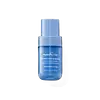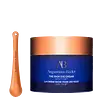What's inside
What's inside
 Key Ingredients
Key Ingredients

 Benefits
Benefits

 Concerns
Concerns

 Ingredients Side-by-side
Ingredients Side-by-side

Water
Skin ConditioningPropanediol
SolventCaprylic/Capric Triglyceride
MaskingGlycerin
HumectantPolyacrylamide
Cetearyl Alcohol
EmollientCocoglycerides
EmollientPotassium Cetyl Phosphate
EmulsifyingDimethicone
EmollientC13-14 Isoparaffin
EmollientLaureth-7
EmulsifyingSodium Hyaluronate
HumectantMenthyl Lactate
MaskingTocopheryl Acetate
AntioxidantPhospholipids
Skin ConditioningRetinol
Skin ConditioningGlyceryl Diretinoate
Skin ConditioningRetinyl Linoleate
Skin ConditioningCopernicia Cerifera Wax
Steareth-20
CleansingChrysin
Skin ConditioningPalmitoyl Tetrapeptide-7
Skin ConditioningPalmitoyl Oligopeptide
CleansingN-Hydroxysuccinimide
Skin ConditioningOryza Sativa Extract
AbsorbentZerumbone
Skin ConditioningButylene Glycol
HumectantMyristoyl Pentapeptide-16
Skin ConditioningMyristoyl Nonapeptide-3
Skin ConditioningCaprylyl Glycol
EmollientPhenoxyethanol
PreservativeWater, Propanediol, Caprylic/Capric Triglyceride, Glycerin, Polyacrylamide, Cetearyl Alcohol, Cocoglycerides, Potassium Cetyl Phosphate, Dimethicone, C13-14 Isoparaffin, Laureth-7, Sodium Hyaluronate, Menthyl Lactate, Tocopheryl Acetate, Phospholipids, Retinol, Glyceryl Diretinoate, Retinyl Linoleate, Copernicia Cerifera Wax, Steareth-20, Chrysin, Palmitoyl Tetrapeptide-7, Palmitoyl Oligopeptide, N-Hydroxysuccinimide, Oryza Sativa Extract, Zerumbone, Butylene Glycol, Myristoyl Pentapeptide-16, Myristoyl Nonapeptide-3, Caprylyl Glycol, Phenoxyethanol
Water
Skin ConditioningGlycerin
HumectantCoco-Caprylate/Caprate
EmollientLimnanthes Alba Seed Oil
Skin Conditioning1,2-Hexanediol
Skin ConditioningSimmondsia Chinensis Seed Oil
EmollientTapioca Starch
Polyglyceryl-4 Oleate
EmulsifyingPolyglyceryl-6 Oleate
EmulsifyingMagnesium Sulfate
Polyhydroxystearic Acid
EmulsifyingSesamum Indicum Seed Oil
EmollientPropanediol
SolventOlea Europaea Leaf Extract
PerfumingSodium Citrate
BufferingSodium Hyaluronate
HumectantO-Cymen-5-Ol
AntimicrobialCitric Acid
BufferingHydrolyzed Rice Protein
Skin ConditioningMaltodextrin
AbsorbentGanoderma Lucidum Stem Extract
Skin ConditioningSodium Lactate
BufferingXanthan Gum
EmulsifyingGentiana Lutea Root Extract
Skin ConditioningCamellia Sinensis Leaf Extract
AntimicrobialHydrogenated Lecithin
EmulsifyingTocopheryl Acetate
AntioxidantTocopherol
AntioxidantCyamopsis Tetragonoloba Gum
Emulsion StabilisingAlanyl Glutamine
HumectantArginine
MaskingOligopeptide-177
Phenylalanine
MaskingPotassium Sorbate
PreservativeSisymbrium Irio Seed Oil
MaskingSodium Chloride
MaskingPalmitoyl Tripeptide-1
Skin ConditioningPalmitoyl Tetrapeptide-7
Skin ConditioningWater, Glycerin, Coco-Caprylate/Caprate, Limnanthes Alba Seed Oil, 1,2-Hexanediol, Simmondsia Chinensis Seed Oil, Tapioca Starch, Polyglyceryl-4 Oleate, Polyglyceryl-6 Oleate, Magnesium Sulfate, Polyhydroxystearic Acid, Sesamum Indicum Seed Oil, Propanediol, Olea Europaea Leaf Extract, Sodium Citrate, Sodium Hyaluronate, O-Cymen-5-Ol, Citric Acid, Hydrolyzed Rice Protein, Maltodextrin, Ganoderma Lucidum Stem Extract, Sodium Lactate, Xanthan Gum, Gentiana Lutea Root Extract, Camellia Sinensis Leaf Extract, Hydrogenated Lecithin, Tocopheryl Acetate, Tocopherol, Cyamopsis Tetragonoloba Gum, Alanyl Glutamine, Arginine, Oligopeptide-177, Phenylalanine, Potassium Sorbate, Sisymbrium Irio Seed Oil, Sodium Chloride, Palmitoyl Tripeptide-1, Palmitoyl Tetrapeptide-7
Ingredients Explained
These ingredients are found in both products.
Ingredients higher up in an ingredient list are typically present in a larger amount.
Glycerin is already naturally found in your skin. It helps moisturize and protect your skin.
A study from 2016 found glycerin to be more effective as a humectant than AHAs and hyaluronic acid.
As a humectant, it helps the skin stay hydrated by pulling moisture to your skin. The low molecular weight of glycerin allows it to pull moisture into the deeper layers of your skin.
Hydrated skin improves your skin barrier; Your skin barrier helps protect against irritants and bacteria.
Glycerin has also been found to have antimicrobial and antiviral properties. Due to these properties, glycerin is often used in wound and burn treatments.
In cosmetics, glycerin is usually derived from plants such as soybean or palm. However, it can also be sourced from animals, such as tallow or animal fat.
This ingredient is organic, colorless, odorless, and non-toxic.
Glycerin is the name for this ingredient in American English. British English uses Glycerol/Glycerine.
Learn more about GlycerinPalmitoyl Tetrapeptide-7 (formerly Palmitoyl Tetrapeptide-3) is a lab-made peptide with anti-inflammatory and skin-repairing benefits. It's made up of four amino acids (glycine, glutamine, proline, and arginine) and palmitic acid (which helps it penetrate skin more effectively).
This ingredient helps reduce inflammation by limiting the production of interleukin-6 (IL-6), a chemical that triggers inflammatory responses, particularly after UV exposure.
Less inflammation = slower collagen breakdown and a longer-lasting, youthful appearance.
Palmitoyl Tetrapeptide-7 also stimulates collagen production and supports a healthier skin barrier.
Over time, this can improve skin firmness, hydration, and reduce the appearance of fine lines. It’s commonly paired with Palmitoyl Tripeptide-1 in the well-known Matrixyl 3000 complex for enhanced anti-aging effects.
This ingredient has been shown to be effective and safe in cosmetic use and you'll typically find it in small amounts (less than 0.01%).
Due to its palmitic acid base, it may not be safe for Malassezia folliculitis.
Read more about other common types of peptides here:
Learn more about Palmitoyl Tetrapeptide-7Propanediol is an all-star ingredient. It softens, hydrates, and smooths the skin.
It’s often used to:
Propanediol is not likely to cause sensitivity and considered safe to use. It is derived from corn or petroleum with a clear color and no scent.
Learn more about PropanediolSodium Hyaluronate is hyaluronic acid's salt form. It is commonly derived from the sodium salt of hyaluronic acid.
Like hyaluronic acid, it is great at holding water and acts as a humectant. This makes it a great skin hydrating ingredient.
Sodium Hyaluronate is naturally occurring in our bodies and is mostly found in eye fluid and joints.
These are some other common types of Hyaluronic Acid:
Learn more about Sodium HyaluronateTocopheryl Acetate is AKA Vitamin E. It is an antioxidant and protects your skin from free radicals. Free radicals damage the skin by breaking down collagen.
One study found using Tocopheryl Acetate with Vitamin C decreased the number of sunburned cells.
Tocopheryl Acetate is commonly found in both skincare and dietary supplements.
Learn more about Tocopheryl AcetateWater. It's the most common cosmetic ingredient of all. You'll usually see it at the top of ingredient lists, meaning that it makes up the largest part of the product.
So why is it so popular? Water most often acts as a solvent - this means that it helps dissolve other ingredients into the formulation.
You'll also recognize water as that liquid we all need to stay alive. If you see this, drink a glass of water. Stay hydrated!
Learn more about Water